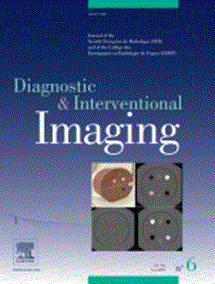盆腔充血综合征的血管内治疗:来自法国心血管影像学学会(SFICV)、介入放射学联合会(FRI)、法国放射学教师学院(CERF)和法国妇女影像学学会(SIFEM)的专家共识声明。
IF 8.1
2区 医学
Q1 RADIOLOGY, NUCLEAR MEDICINE & MEDICAL IMAGING
引用次数: 0
摘要
目的:盆腔充血综合征(PCS)是育龄妇女慢性盆腔疼痛的主要原因。它常伴有盆腔静脉功能不全和卵巢、子宫静脉扩张,导致多种症状因静脉高压而加重。尽管流行,但PCS缺乏标准化的诊断和管理方案,使有效治疗具有挑战性。本专家共识声明的目的是总结法国放射科医生和妇科医生对PCS的诊断、成像、治疗和管理的意见。材料和方法:由来自法国各医疗中心的14名放射科专家和妇科专家组成的工作组采用德尔菲小组方法,通过几轮远程和面对面会议,根据当前文献和临床专业知识制定和完善专家意见。这些意见根据诊断标准、成像技术、治疗方案和随访方案进行分类。结果:小组形成了72条初步意见,其中65条经过严格的评估一致保留。主要的诊断工具包括用于检测静脉回流的多普勒超声和用于详细评估静脉解剖的磁共振成像。血管内栓塞被强调为主要的治疗方法,并在充分的影像学评估后推荐。强调无创治疗和多学科综合护理。专家意见还包括治疗后随访,以评估生活质量和症状缓解。结论:这种结构化的共识方法有助于形成标准化的专家意见,为诊断、治疗和随访提供明确的指导。这些指南应改善临床实践和患者护理的管理PCS。本文章由计算机程序翻译,如有差异,请以英文原文为准。
Endovascular management of pelvic congestion syndrome: An expert consensus statement from the French Society of Cardiovascular Imaging (SFICV), Interventional Radiology Federation (FRI), College of French Radiology Teachers (CERF), and French Society of Women's Imaging (SIFEM)
Purpose
Pelvic congestion syndrome (PCS) is a major cause of chronic pelvic pain in women of reproductive age. It is often associated with pelvic venous insufficiency and venous dilatation of the ovarian and uterine veins, resulting in a variety of symptoms exacerbated by venous hypertension. Despite its prevalence, PCS lacks standardized diagnostic and management protocols, making effective treatment challenging. The purpose of this expert consensus statement was to summarize the opinions of French radiologists and gynecologists regarding the diagnosis, imaging, treatment, and management of PCS.
Materials and methods
A working group of 14 expert radiologists and gynecologists from various French medical centers used a Delphi panel approach with several rounds of remote and face-to-face meetings to formulate and refine expert opinions based on the current literature and clinical expertise. These opinions were categorized according to diagnostic criteria, imaging techniques, therapeutic options, and follow-up protocols.
Results
The group formulated 72 initial opinions, and 65 were retained after rigorous evaluation for consensus. Key diagnostic tools include Doppler ultrasound for detection of venous reflux and magnetic resonance imaging for detailed assessment of venous anatomy. Endovascular embolization was highlighted as the primary treatment approach and recommended after thorough imaging evaluation. Noninvasive treatments and multidisciplinary care were also emphasized for comprehensive management. The expert opinion also included post-treatment follow-up to assess quality of life and symptom resolution.
Conclusion
This structured consensus approach helped develop standardized expert opinions on management of, providing clear guidelines for diagnosis, treatment, and follow-up. These guidelines should improve clinical practice and patient care in the management of PCS.
求助全文
通过发布文献求助,成功后即可免费获取论文全文。
去求助
来源期刊

Diagnostic and Interventional Imaging
Medicine-Radiology, Nuclear Medicine and Imaging
CiteScore
8.50
自引率
29.10%
发文量
126
审稿时长
11 days
期刊介绍:
Diagnostic and Interventional Imaging accepts publications originating from any part of the world based only on their scientific merit. The Journal focuses on illustrated articles with great iconographic topics and aims at aiding sharpening clinical decision-making skills as well as following high research topics. All articles are published in English.
Diagnostic and Interventional Imaging publishes editorials, technical notes, letters, original and review articles on abdominal, breast, cancer, cardiac, emergency, forensic medicine, head and neck, musculoskeletal, gastrointestinal, genitourinary, interventional, obstetric, pediatric, thoracic and vascular imaging, neuroradiology, nuclear medicine, as well as contrast material, computer developments, health policies and practice, and medical physics relevant to imaging.
 求助内容:
求助内容: 应助结果提醒方式:
应助结果提醒方式:


